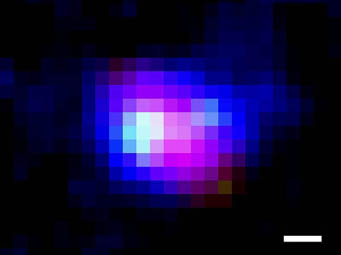Last week my interest was piqued by a news release from the Carnegie Institution of Washington about an enormous blob of matter discovered by CIW fellow Masami Ouchi and an international team of collaborators.

Astronomers estimate that this incredibly distant, galaxy-size object formed when the universe was only 800 million years old. The white bar at lower right corresponds to a width of 10,000 light-years.
Masami Ouchi & others
The object spans some 55,000 light-years, roughly the size of a galaxy. This alone wouldn't make it noteworthy, since astronomers know of other large masses in the early universe. What does, however, is its age. Based on the extreme redshifting of its hydrogen spectrum, from a rest wavelength of 121.6 nanometers in the ultraviolet to 923 nm in the infrared, Ouchi estimates that this primordial blob is 12.9 billion light-years away.
In other words, this object, located in the constellation Cetus, came together when the universe was about 800 million years old. (Astronomers can't really see farther back in time, because for a half billion years beforehand space was filled with opaque gas. Only when the first galaxies and quasars "turned on," ionizing much of the gas, did the universe become transparent to light.)
It's an important discovery, because astronomers hadn't believed such a large structure (with an estimated mass of 40 billion Suns) could have assembled so soon after the Big Bang.
But what is it, exactly? As the team notes in May 10th's Astrophysical Journal, it could be a massive gas cloud energized by a supermassive black hole, a primordial galaxy gobbling up gas from its surroundings, two young galaxies colliding, or a single massive galaxy.
Whatever its origin, the big blob now has a name: Himiko. Ouchi and his team discovered it with Japan's Subaru telescope atop Mauna Kea in Hawaii, so they named it after a mysterious, ancient queen in Japanese folklore.
 4
4
Comments
Philip
May 1, 2009 at 10:32 am
S&T has an article that a GBR has been found 630 million years after the Big Bang:
http://skyandtelescope.org/community/skyblog/newsblog/43700627.html
This contradicts this article with its claim that Himiko is the oldest object possibly visible because the universe was filled with opaque gas for "half a billion years beforehand."
Never say never?
You must be logged in to post a comment.
Dr. Gottfried Beyvers
May 1, 2009 at 2:43 pm
... and there are more errors:
1. The universe did not become transparent for light BY IONIZATION, but by REIONIZATION 380.000 years after the big bang.
2. And the distance given ("12.9 billion ly") is again wrong - compare my letter to S&T in the May issue.
Dr. Gottfried Beyvers
Box 1223
84058 Ergoldsbach/Germany
You must be logged in to post a comment.
Mr. Wm Patten
May 3, 2009 at 7:35 am
In response to comment from Phil ..in #1 comment....
At no time does this article state that Himiko is the Oldest thing ever seen....and 630 million years after the BigBang is not further back then 500 million years..( Half a Billion).
Although to be fair...The author does use a very rough estimate when stating about 800 million as a limit.
You must be logged in to post a comment.
Mr. Wm Patten
May 3, 2009 at 7:35 am
In response to comment from Phil ..in #1 comment....
At no time does this article state that Himiko is the Oldest thing ever seen....and 630 million years after the BigBang is not further back then 500 million years..( Half a Billion).
Although to be fair...The author does use a very rough estimate when stating about 800 million as a limit.
You must be logged in to post a comment.
You must be logged in to post a comment.